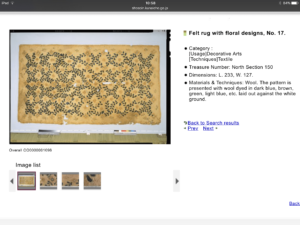“Textile Society of America (TSA) invites you to participate in the Vancouver 2018 Symposium members’ juried exhibition of small works exploring the theme: Social Fabric: Deep Local to Pan Global. We are calling for an original textile artwork that is inspired by a specific landmark or object in your community or museum.”
“We are very pleased to inform you that your submissions have been accepted for the Members’ Exhibition show at The Social Fabric: Deep Local to Pan Global, the Textile Society of America’s 16th Biennial Symposium, to be held in Vancouver, BC, September 19-23, 2018. The pieces represent a wide range of themes and techniques, and it will be interesting to see how they add to the rest of the event.”
(L) Felt, Shrink to Fit: I (Sappanwood)
(R) Felt, Shrink to Fit: III (Weld, Sappanwood, Madder, Indigo)
JJ Exhibition submission abstract:
The Shoso-in Repository of the Imperial Household Agency of Japan, Nara, houses the 8th c. T’ang Dynasty collection of extraordinary floral patterned felt carpets. As Japan has never been a sheep herding country it is doubly remarkable that the rarest felt carpet collection is here. Originally stored in bug repellent wooden chests of cedar, and those in a huge repository of cypress timber , 4.7m above ground, they have been well preserved.
“Kasen no. 17” Felt rug with floral design, Tang Dynasty, w. 127 cm x l. 233 cm, cut prefelt inlay wool motif, folded edges on four sides, Shosoin Repository, Nara, Japan
The art of feltmaking truly evolved by the wool belt around the globe; wherever mankind has roamed so has his flock. But where and why his art work has ended up in storage in such distant, yet interesting places, as the Shoso-in, Nara, Japan, has become my own personal Sherlock Holmes’ investigation.
As one elementary example of the technical capabilities of feltmaking design, I used ONE triangular form to generate various cut motifs as discovered through my analysis. These two small works were shrunk to the mandatory size and are more explorations than “art” pieces for much larger works in the future.
Fields of natural colored flora draw me to ponder when the art of feltmaking, after thousands of years, really started to change? We can mark that somewhat by breed development, distribution capabilities, carding equipment innovation, less need for survival and protection, and so on.
No matter what century, though, the strategies of production boil down to limiting waste, speedier manufacturing, current modes, sales push,…some things never change. I have found that to research with “The Maker’s Mind” and an openness to the honesty of the material, answers come more easily than imagined.
Jorie Johnson Bio:
American textile artist, Jorie Johnson, has been a member of the Shoso-in research team since 2011. Her feltmaking career began in 1978, at the far western end of the Silk Road, in Finland with a pair of Scandinavian boots.
Through investigation of the felt objects and practical sampling of comparable techniques found today, she is preparing a report that culminates in the 2020 Shoso-in exhibition highlighting these Kasen carpets.
Born into a Boston wool merchant family, she studied textiles at RISD and in Finland; her works have been collected by the V&A, London, MFA Boston and other institutions and universities.

